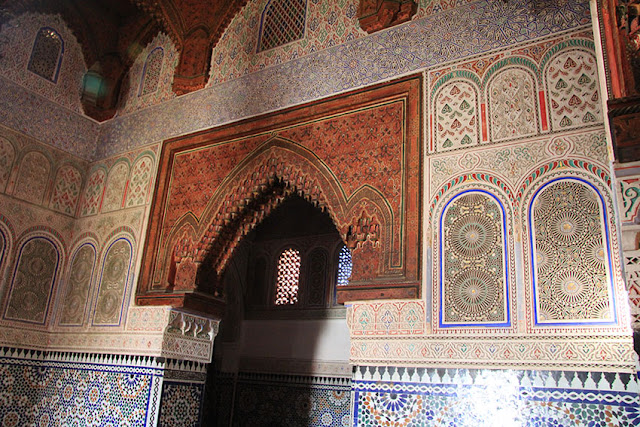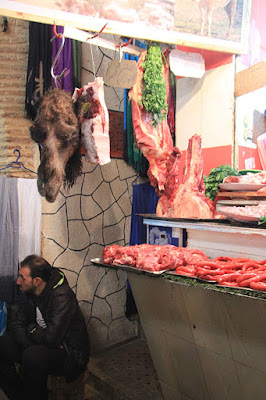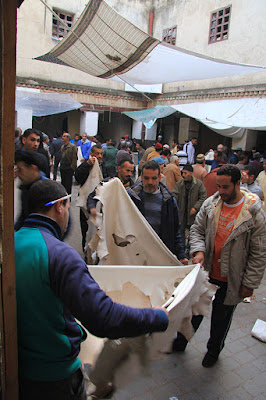 |
| Medina de Rabat |
Rabat
Para
ser una ciudad que no tiene la fama de ser turística, me sorprendió. Su medina
sin ser ni de lejos la de ciudades como Fez o Marrakest, guarda un encanto
entre modernidad y tradición, que la hacen merecedora de una visita. Además hay
que añadirle el hecho de que es una ciudad frente al Atlántico lo que le brinda un clima templado y agradable y es de resaltar el hecho de que es prácticamente llana, por lo que es
muy cómoda para pasear. Algunos sitios a visitar:
Old Medina, with it's various street markets
(souqs). The side street leading to the Kasbah (Rue des Consuls) is full of
history and traditional shops. The Tourist Police is also stationed
there. Un dato importante es que la medina no tiene pérdida absolutamente ninguna,
las calles son anchas y es pequeña. Nada que ver con las de Meknes, Fez o
Marrakest.
Kasbah of the Oudaias, the picturesque medieval Almohadan
fortress citadel, with commanding ocean views from the acropolis and refreshing
Andalusian gardens on it's base. The Beach and the cornice around the Kasbah,
offering great photo ops to the citadel.
Hassan Tower (Le Tour Hassan) and
the Royal Mausoleum.
With the Royal Guards (Tower is currently under renovation. Es el monument más
famoso de Rabat.
Chellah. Old city founded by Carthaginians, conquered
by Romans and later passed under Arab rule, just to be abandoned and settled
again by unbelievable numbers of birds, namely storks. This breeding ground
bubbles with bird life in spring, including stork nest on the top of old
minaret. Also, historical layers are visible, with outstanding Roman and
Moroccan parts. You can walk there from centre-ville, but it's a long walk.
Royal Palace. It's pretty huge, you can't really visit it (but it's a nice
walk!), the armed guards might allow you walk from one entrance to another
especially if you look like a tourist. Al sur de la estación de tren.
Meknes
Es
la tercera ciudad imperial del pais, detrás de Marrakest y Fez, y desde luego
lo merece. Su medina, Palacios y la vitalidad de la plaza al atardecer te dejan
un buen recuerdo de la ciudad. Algunos sitios a visitar:
Bab
Mansour. Bab means
"gate" or "door" in Arabic, and Bab Mansour is the largest
and most striking of Meknes' many gates (27 gates). It's directly across from Place Hedim, the medina's main square.
Place
Hedim. Recently
redone with new brickwork, this square once rivaled Djemaa el Fna in Marrakech but is now significantly less exciting
(though there are a few nice cafes and snack spots in which to people-watch).
Dar Jamai. Now a museum (Musèe Dar Jamai in
French), this old palace is located at the back of Place Hedim. It now houses
the Museum of Moroccan Arts, which is currently exhibiting artifacts, jewels,
and old copies of the Qur'an. Dar Jamai is a gorgeous museum with exqusite
gardens on the outside. Lovely museum! Abierto de 9 a 12 y de 15 a 18:30
hrs. Entrada 10 MAD.
Grand Mosque. No es visitable para los no
musulmanes.
Medersa Bou Inania. Junto a la
mezquita anterior. A beautiful Qur'anic school. Abierto de 9 a 12 y de 15 a
18:30 hrs. Entrada 10 MAD.
Mausoleum
of Moulay Ismail. Although non-Muslims are not permitted to enter, they can view the
tombs, which hold the body of Moulay Ismail and other relatives, from the
entrance. Abierto de 8:30 a 12 y de 14:00 a 18:00 hrs. Entrada gratuita.
Heri
es-Souani. You can
catch a glimpse of the grandeur of Moulay Ismail at these granaries, and sit
beside the enormous Agdal Basin.
A 1 kilómetro a las afueras de la ciudad. Yo no fui.
Koubbat as-Sufara. Abierto de 9 a 12 y de 15 a 18:30
hrs. Entrada 10 MAD. En su día fue la sala de recepción de los
embajadores extranjeros. No vale la pena. No vale nada. Es una habitación
vacía. Con la entrada aquí te dejan ver el antiguo depósito de agua de la
ciudad que está al lado, que tampoco tiene interés.
Museo
de Meknes. Está junto a la puerta Bab Mansour. No vale nada. No merece la
pena. Entrada 10 MAD.
Fez
Tiene
la medina más grande del país y probablemente la más vistosa de todas. Sus calles
estrechas con multitud de tiendas hacen de esta medina un entretenido paseo que
puede durar varios días. Famosa por su gastronomía, artesanía, buenos hoteles y
hamanes, hacen de esta ciudad una parada obligatoria en la ruta. Algunos sitios
a visitar:
Mosque
Qaraouyine. Es el corazón espiritual de Marruecos. Los no musulmanes
tenemos prohibida la entrada.
Bou
Inania Madersa. Entrada 10 MAD. Hr: 8:00 a 17:00 hrs. Es la escuela
teológica más bella de las construidas por los Benimerín. Durante las horas de oración permanece cerrada.
A breathtaking 14th-century religious college. The best example of Islamic
architecture a non-Muslim can see in Fez, with wooden walls elaborately carved
with geometric patterns and Arabic calligraphy, and a beautiful minaret. In the
courtyard there is a portico with a still-functioning mosque, separated by the
rest of the courtyard by a small moat.
El-Attarine
Madersa. Entrada 10 MAD. Hr: 8:00 a 13 y de 14:30 a 17:00 hrs.
Museo
Nejjarine de Arte y Artesanía de la Madera. Entrada 20 MAD. Hr: 10:00 a
17:00 hrs. Prohibida las fotos. Está en un antiguo caravasar muy bien
restaurado, de modo que el edificio merece la pena.
Museo
Dar Batha. Entrada 10 MAD. Hr: 8:30 a 12 y de 14:30 a 18:00 hrs. Cerrado los martes. Muy bueno. Lo mejor es la
colección de cerámica.
Museo
Belghazi. Entrada 20 MAD. Hr: 9:00 a 18:30 hrs. Es de propiedad privada,
pero merece la pena ya que rivaliza con el anterior. Está en plena medida, pero
desde la Madraza de Qarawiyin está bien señalizado. En el patio tiene unas
mesas para tomar té que son bastante agradables.
Curtidurías
(tanneries). Hay dos curtidurías en la Medina. Una de ellas se puede ver
sin problemas desde el balcón de la tienda de artículos de cuero que hay en
frente del Museo Belghazi. Se entra en la tienda y se pide ver las curtidurías
y te suben gratis, luego te intentan vender algo.
Moulay Idriss II shrine. The tomb of Fez's founder, is
limited to Muslims, but the view from just outside its doors is still
well-worth hunting down. The mosque is just off the Talaa Kbira near the Souk
Attarine.
The Merenid Tombs next to the Merenid Hotel, provide
excellent panoramic views over the medina and the wider city, as well as the
olive tree lined hills surrounding the city, and sanctuary from the bustle of
the rest of the city. Beware of the odd opportunistic tout.
The Sofitel Palais Jamai. The terrace has an incredible view
over the medina if you are willing to pay 30 dirhams for a glass of tea in
order to access it. This is particularly worthwhile if you can time your visit
to coincide with the call to prayer, as you can hear multiple minarets from the
terrace.
Dar
El-Makhzen. Palacio Real. No se puede visitar.
Chefchaouen
Es
probablemente uno de los pueblos con más encanto del país. De entre los pueblos
de montaña o interior éste es el más famoso. Su medina, con calles estrechas y
casas encaladas de añil o índigo hacen de este pueblo un signo distintivo. Algunos
sitios a visitar:
The medina is the focal point of interest for
most visitors to Chefchaouen. Walking around the town with its whitewashed
walls, originally decorated in this style by Jewish immigrants, can be a nice
change to the hustle and bustle of the cities of Marrakech, Rabat, and Fez.
The waterfall (Ras el Maa) to the east of the medina is a
meeting point for local residents who come to cool off, chat and do their
laundry (including carpets on sunny sundays). The café nearby is rather expensive,
however it's a nice change from the main square.
The ruins of an old mosque (Jemaa
Bouzafar), on a
hill behind the waterfall, overlook the medina and its crumbling tower offers
great views of the town.
The Kasbah. Looks quite interesting from the
outside, but there isn't much to see inside. The place is well preserved.
There's the tower and the prison amongst others that's worth a visit, and the
courtyard is green and almost alien amdist the mountain setting. Should only be
an option if you're either bored or want to get away from the bustle outside.
20 MAD.
The hill of the Hotel Atlas is a good viewpoint on the town and
the valley, especially on sunsets. It can be reached from the south gate of the
medina (Bab el-Ain) by climbing the road coasting the medina on the west side
until the east gate (Bab Souk), and then uphill, crossing the old cemetery on a
rocky path.
Tánger
No
es una ciudad que especialmente me guste. Tiene un ambiente que no se bien como
describirlo, pero desde luego no es como cualquiera de las ciudades que he
descrito anteriormente. Tan solo la tomo como punto de salida del país, y como
visita obligada, ya que después de todo fue la ciudad que entre 1925 y 1960 se
transformó en una notoria Zona Internacional, políticamente neutral y
económicamente abierta. Definida por Mohamed Choukri, cronista oficioso del
inframundo tangerino, como "la más extraordinaria y misteriosa ciudad del
mundo", Tánger fue el destino exótico por excelencia de buena parte de la
intelectualidad europea y norteamericana de la época.






































